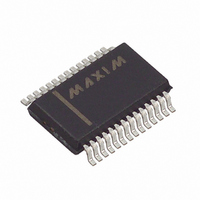MAX1401EAI+ Maxim Integrated Products, MAX1401EAI+ Datasheet - Page 14

MAX1401EAI+
Manufacturer Part Number
MAX1401EAI+
Description
IC ADC 18BIT LP 28-SSOP
Manufacturer
Maxim Integrated Products
Datasheet
1.MAX1401EAI.pdf
(36 pages)
Specifications of MAX1401EAI+
Number Of Bits
18
Sampling Rate (per Second)
480
Data Interface
QSPI™, Serial, SPI™
Number Of Converters
1
Power Dissipation (max)
750µW
Voltage Supply Source
Analog and Digital
Operating Temperature
-40°C ~ 85°C
Mounting Type
Surface Mount
Package / Case
28-SSOP
Number Of Adc Inputs
5
Architecture
Delta-Sigma
Conversion Rate
4.8 KSPs
Resolution
18 bit
Input Type
Voltage
Interface Type
Serial
Voltage Reference
External
Supply Voltage (max)
3 V
Maximum Power Dissipation
21.45 mW
Maximum Operating Temperature
+ 85 C
Mounting Style
SMD/SMT
Input Signal Type
Pseudo-Differential, Differential
Minimum Operating Temperature
- 40 C
Lead Free Status / RoHS Status
Lead free / RoHS Compliant
+3V, 18-Bit, Low-Power, Multichannel,
Oversampling (Sigma-Delta) ADC
The serial digital interface provides access to eight on-
chip registers (Figure 3). All serial-interface commands
begin with a write to the communications register
(COMM). On power-up, system reset, or interface reset,
the part expects a write to its communications register.
The COMM register access begins with a 0 start bit.
The COMM register R/W bit selects a read or write
operation, and the register select bits (RS2, RS1, RS0)
select the register to be addressed. Hold DIN high
when not writing to COMM or another register (Table 1).
The serial interface consists of five signals: CS, SCLK,
DIN, DOUT, and INT. Clock pulses on SCLK shift bits
into DIN and out of DOUT. INT provides an indication
that data is available. CS is a device chip-select input
as well as a clock polarity select input (Figure 4).
Using CS allows the SCLK, DIN, and DOUT signals to be
shared among several SPI-compatible devices. When
short on I/O pins, connect CS low and operate the serial
digital interface in CPOL = 1, CPHA = 1 mode using
SCLK, DIN, and DOUT. This 3-wire interface mode is
ideal for opto-isolated applications. Furthermore, a
microcontroller (such as a PIC16C54 or 80C51) can use
a single bidirectional I/O pin for both sending to DIN and
receiving from DOUT (see Applications Information),
because the MAX1401 drives DOUT only during a read
cycle.
Additionally, connecting the INT signal to a hardware
interrupt allows faster throughput and reliable, collision-
free data flow.
The MAX1401 features a mode where the raw modula-
tor data output is accessible. In this mode the DOUT
and INT functions are reassigned (see the Modulator
Data Output section).
Table 1. Control Register Addressing
14
RS2
0
0
0
0
1
1
1
1
______________________________________________________________________________________
RS1
0
0
1
1
0
0
1
1
RS0
0
1
0
1
0
1
0
1
Communications Register
Global Setup Register 1
Global Setup Register 2
Special Function Register
Transfer Function Register 1
Transfer Function Register 2
Transfer Function Register 3
Data Register
Serial Digital Interface
TARGET REGISTER
Figure 3. Register Summary
Figure 4. Serial-Interface Timing
(CPOL = 1)
(CPOL = 0)
*DOUT IS HIGH IMPEDANCE DURING THE WRITE CYCLE; DIN IS IGNORED
DURING THE READ CYCLE.
(DURING
(DURING
WRITE)*
DIN
READ)*
DOUT
DOUT
SCLK
SCLK
INT
DIN
CS
t
1
t
3
t
SPECIAL FUNCTION REGISTER
t
t
COMMUNICATIONS REGISTER
12
t
6
4
14
XFER FUNCTION REGISTER 1
XFER FUNCTION REGISTER 2
XFER FUNCTION REGISTER 3
GLOBAL SETUP REGISTER 1
GLOBAL SETUP REGISTER 2
DATA REGISTER D1–D0/CID
DATA REGISTER D17–D10
t
13
t
RS2
DATA REGISTER D9–D2
5
MSB D6
MSB D6
RS1
RS0
t
15
D5
D5
t
t
16
7
t
t
17
8
D4
D4
D3
D3
D2
D2
D1
D1
REGISTER
DECODER
SELECT
D0
D0
t
10
t
t
18
9
t
11











